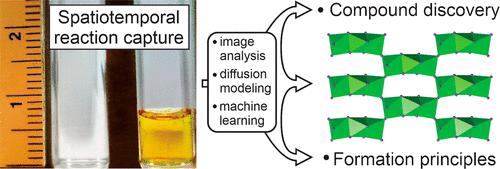当前位置:
X-MOL 学术
›
Chem. Mater.
›
论文详情
Our official English website, www.x-mol.net, welcomes your
feedback! (Note: you will need to create a separate account there.)
Spatiotemporal Route to Understanding Metal Halide Perovskitoid Crystallization
Chemistry of Materials ( IF 7.2 ) Pub Date : 2022-06-07 , DOI: 10.1021/acs.chemmater.2c00247 Mansoor Ani Najeeb Nellikkal 1 , Rodolfo Keesey 1, 2 , Margaret Zeile 1 , Venkateswaran Shekar 1 , Zhi Li 3 , Nicholas Leiby 4 , Matthias Zeller 5 , Emory M. Chan 3 , Joshua Schrier 2 , Alexander J. Norquist 1
Chemistry of Materials ( IF 7.2 ) Pub Date : 2022-06-07 , DOI: 10.1021/acs.chemmater.2c00247 Mansoor Ani Najeeb Nellikkal 1 , Rodolfo Keesey 1, 2 , Margaret Zeile 1 , Venkateswaran Shekar 1 , Zhi Li 3 , Nicholas Leiby 4 , Matthias Zeller 5 , Emory M. Chan 3 , Joshua Schrier 2 , Alexander J. Norquist 1
Affiliation

|
A spatiotemporal experimental route is reported for the antisolvent vapor diffusion crystal growth of metal halide perovskitoids. A computational analysis combining automated image capture and diffusion modeling enables the determination of the critical concentrations required for nucleation and crystal growth from a single experiment. Five different solvent systems and ten distinct organic ammonium iodide salts were investigated with lead iodide, from which nine previously unreported compounds were discovered. Automated image capture of the mother liquor and antisolvent vials was used to determine changes in solution meniscus positions and detect the nucleation event location. Matching the observations to a numerical solution of Fick’s second law diffusion model enables the calculation of reactant, solvent, and antisolvent concentrations at both the time and position of the first stable nucleation and crystal growth. A machine learning model was trained on the resulting data, and it reveals solvent- and amine-specific crystallization tendencies. Solvent systems that interact more weakly with dissolved lead species promote crystallization, while those with stronger interactions can prevent crystallization through increased solubilities. Organic amines that interact more strongly with inorganic components and exhibit greater rigidity are more likely to be incorporated into crystalline products.
中文翻译:

了解金属卤化物类钙钛矿结晶的时空路径
报道了金属卤化物类钙钛矿的反溶剂蒸气扩散晶体生长的时空实验路线。结合自动图像捕获和扩散建模的计算分析能够从单个实验中确定成核和晶体生长所需的临界浓度。用碘化铅研究了五种不同的溶剂系统和十种不同的有机碘化铵盐,从中发现了九种以前未报道的化合物。使用母液和抗溶剂瓶的自动图像捕获来确定溶液弯月面位置的变化并检测成核事件的位置。将观察结果与 Fick 第二定律扩散模型的数值解相匹配,可以计算反应物、溶剂、和第一次稳定成核和晶体生长的时间和位置的反溶剂浓度。对结果数据进行了机器学习模型的训练,它揭示了溶剂和胺特定的结晶趋势。与溶解的铅物质相互作用较弱的溶剂系统会促进结晶,而相互作用较强的溶剂系统可以通过增加溶解度来防止结晶。与无机组分相互作用更强烈并表现出更大刚性的有机胺更有可能结合到结晶产品中。与溶解的铅物质相互作用较弱的溶剂系统会促进结晶,而相互作用较强的溶剂系统可以通过增加溶解度来防止结晶。与无机组分相互作用更强烈并表现出更大刚性的有机胺更有可能结合到结晶产品中。与溶解的铅物质相互作用较弱的溶剂系统会促进结晶,而相互作用较强的溶剂系统可以通过增加溶解度来防止结晶。与无机组分相互作用更强烈并表现出更大刚性的有机胺更有可能结合到结晶产品中。
更新日期:2022-06-07
中文翻译:

了解金属卤化物类钙钛矿结晶的时空路径
报道了金属卤化物类钙钛矿的反溶剂蒸气扩散晶体生长的时空实验路线。结合自动图像捕获和扩散建模的计算分析能够从单个实验中确定成核和晶体生长所需的临界浓度。用碘化铅研究了五种不同的溶剂系统和十种不同的有机碘化铵盐,从中发现了九种以前未报道的化合物。使用母液和抗溶剂瓶的自动图像捕获来确定溶液弯月面位置的变化并检测成核事件的位置。将观察结果与 Fick 第二定律扩散模型的数值解相匹配,可以计算反应物、溶剂、和第一次稳定成核和晶体生长的时间和位置的反溶剂浓度。对结果数据进行了机器学习模型的训练,它揭示了溶剂和胺特定的结晶趋势。与溶解的铅物质相互作用较弱的溶剂系统会促进结晶,而相互作用较强的溶剂系统可以通过增加溶解度来防止结晶。与无机组分相互作用更强烈并表现出更大刚性的有机胺更有可能结合到结晶产品中。与溶解的铅物质相互作用较弱的溶剂系统会促进结晶,而相互作用较强的溶剂系统可以通过增加溶解度来防止结晶。与无机组分相互作用更强烈并表现出更大刚性的有机胺更有可能结合到结晶产品中。与溶解的铅物质相互作用较弱的溶剂系统会促进结晶,而相互作用较强的溶剂系统可以通过增加溶解度来防止结晶。与无机组分相互作用更强烈并表现出更大刚性的有机胺更有可能结合到结晶产品中。











































 京公网安备 11010802027423号
京公网安备 11010802027423号